Growing Corn For The Sweetest, Plumpest Ears
As an Amazon Associate and member of other affiliate programs, I earn from qualifying purchases.
Growing corn is practically an American tradition. Corn has been grown in our country for thousands of years.
And for good reason. Corn is very nutritious containing many vitamins, minerals, fiber, and antioxidants. You can eat it fresh, cook it, preserve it, and grind it into flour.
If you’ve never bitten into a sweet, juicy ear of homegrown corn, then you’re really missing out!
Fresh homegrown sweet corn is better than what you can buy at the store. Eat your garden fresh corn raw, right off the stalk or grill it for a delicious summer treat.
In this post, I’m going to show you a few tips and tricks for planting sweet corn in your garden and show you what to do to make sure you get the sweetest, plumpest ears.
First things first: know what kind of corn you’re growing.
One of the most important factors to consider when you’re growing corn is making sure you get the right kind of corn seed.
Corn is one of the most commonly grown GMO crops in our country. Most home gardeners won’t have to worry about accidentally growing GMO corn in their garden, but if you live near large corn fields it’s very likely the corn grown there is genetically modified unless it’s a certified organic farm.
Because corn is wind pollinated, there is a chance that GMO pollen could get on your corn plants. For the purposes of home gardeners, I wouldn’t worry about it. If you’re a certified organic farmer thinking of adding corn to your farm, then it’s definitely something you need to consider.
Aside from the GMO aspect, you need to make sure you’re growing the right type of corn.
There’s sweet corn for fresh eating and cooking, popping corn for popping, field corn used to make flour and other food items, and ornamental corns.
Field Corn
Also known as dent corn and flint corn, field corn is corn grown for animal feed, cornmeal, and corn syrup among other things. It’s also the type of corn planted in corn mazes.
Farmers plant entire fields of this type of corn and harvest it after the plants are dead and the ears have dried. It can be eaten if picked when ripe and eaten right away, but this type of corn is not as sweet as sweet corn.
The sugars in this kind of corn are linked together in chains forming starches. The long chains of sugars don’t taste as sweet to us, but they are a good source of slow release nutrition for farm animals, and the starchiness is great for making cornmeal and cornstarch.
Sweet Corn
Sweet corn is a naturally occurring mutation of field corn in which the sugars are not linked together to form starches so the flavor is sweeter. However, the sugars begin converting to starch and the sweetness starts to fade as soon as the ear is picked from the plant.
To combat this, farmers have been breeding sweet corn for higher sugar content and improved shelf life for many years. So a lot of the popular varieties of sweet corn are hybrid varieties.
This is not the same thing as genetically modified, and you shouldn’t worry about needing to avoid planting hybrid sweet corn seed. Read about hybrid plants here.
Some types of corn are bred to be super duper sweet, some are just super sweet, and some are bred to hold on to that sweetness longer. They’re also bred for improved vigor, production, and disease and pest resistance.
Popping and Ornamental Corn
Popping corn is a starchy corn with a hard kernel shell, and, like field corn, it is harvested after the plants have died and the ears have dried up.
Ornamental corn is a starchy corn that is also grown for its appearance. The corn may be red, purple, striped, or multi-colored. Sometimes the stalks of these plants are also ornamental.
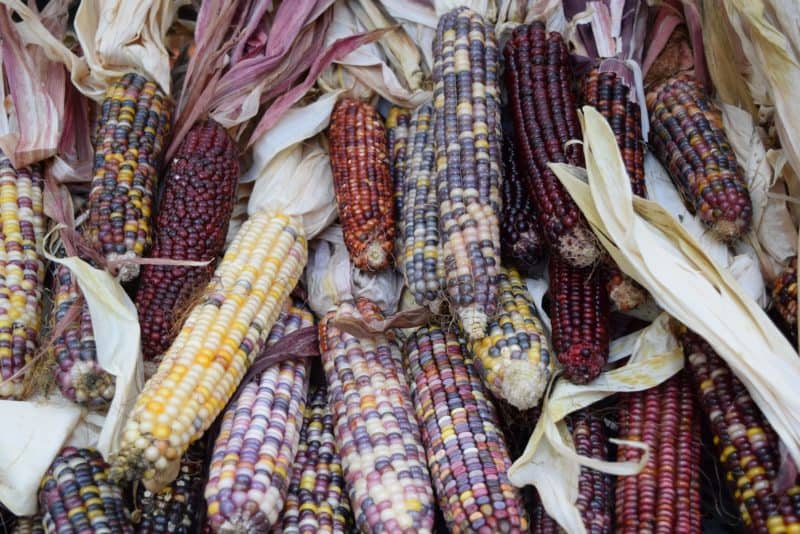
Side note about the different types of corn
Every variety has a different taste and purpose. But any kind of corn can be eaten when it’s fresh and soft, and any kind can be ground down to cornmeal when it’s hard and dry. You can even try to pop any dried corn.
The different varieties and types of corn work best for their specific purposes. But it’s really all just corn.
This is not a recommendation that you start growing field corn for fresh eating. You can if you want to, but it’s not going to taste like sweet corn.
Likewise, if you use sweet corn for cornmeal, be prepared to account for the increased sugar content in the flour.
Tips for buying corn seed
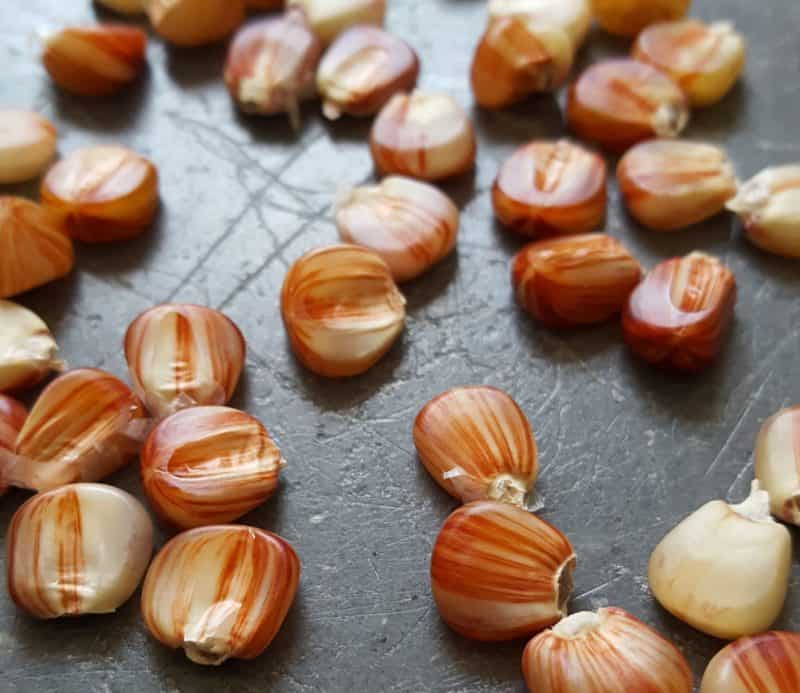
The best advice for choosing the right corn seed for your garden is to know what you need and want, then read the descriptions of the varieties in your seed catalog to make sure that type fits your needs.
We buy our seeds from Johnny’s, Baker Creek, and Burpee. We prefer organic, untreated seeds, but you can get seeds that are pre-treated with fungicide and pesticides.
You can even use a bag of deer corn for planting, but don’t expect great germination. Deer corn is field corn and may have been sprayed with pesticides and herbicides when it was growing. So keep these things in mind as well.
Can you grow corn from an ear of corn?
Sure. Probably.
Corn seeds are really just dried corn kernels. So you can try growing corn from an ear of corn. Just let the ear dry out and plant the kernels.
Some things to consider when shopping for corn seed:
- How much space do you have to grow corn?
Because most varieties of corn make only one or two ears per stalk, you want to make sure you allow plenty of space in your garden for growing corn.
If you don’t have a lot of space, look for varieties that make up to 4 ears of corn per plant.
Not sure how much corn to plant? My garden planning spreadsheets can help you out.
- How long is your growing season?
Corn is a warm weather crop that won’t tolerate frost. Depending on the variety, corn can be ready to harvest anywhere from 60 to 90 days after planting.
Make sure you check the time between your last frost date in the spring and your first frost date in the fall to know the length of your growing season.
- When to plant corn
Plant your corn after the last chance of frost. You can plant more corn every 10 days up until 60-90 days before your first frost. Just make sure the variety you’re growing will have time to ripen before it gets too cold.
- How are you planning to use your corn?
Check the descriptions of the corn variety to make sure it will suit your needs. If you plant a colorful popping corn but are expecting sweet corn, you may find yourself disappointed.
- Do you need disease resistant varieties?
If you’ve grown corn before and had trouble with cutworms, wilt, or smut, try growing a variety resistant to these diseases.
We’re growing Country Gentlemen, an heirloom shoe-peg variety, that can make 3 or more ears per stalk. The irregular kernel pattern on this variety is beautiful, but it’s not a super sweet type corn.
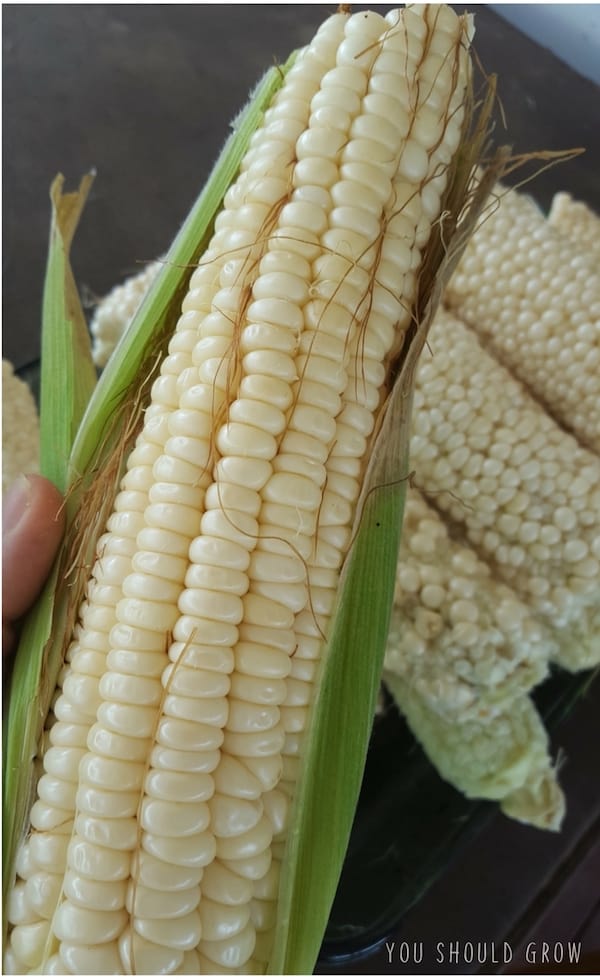
How To Grow Corn At Home
Now that you have your seed, it’s time to talk about how to grow corn. The first step in growing corn is getting it planted. There are a few tips you should know before you get started.
https://www.instagram.com/p/BU5kAmOhGOA/?taken-by=laura.ysg
Follow these tips for planting corn:
Where to plant corn
Choose a sunny location protected from strong gusts of wind.
Try to locate your corn where it will get at least 8 hours of sunlight per day. Even the knee-high stalks of corn can be laid down by a strong gust of wind, so make sure to avoid parts of your property that get the most wind if you can.
Because corn stalks are prone to falling over, it’s a good idea to ‘hill-up’ your corn plants when they are a few inches tall. Hilling up is the term we use for pushing dirt up a couple inches around the stalk. This encourages the stalk to put out more roots to help stabilize the stalk.
Take a look at this video so you can see what I mean.
Watch the weather
Corn is not tolerant of frost so make sure you plant after the very last chance of frost. Use plastic mulch to increase the soil temperature to a minimum of 60 degrees F if needed.
If you see a few rainy days ahead, it’s a great idea to go out and get your seeds in the ground. Seeds will need water to sprout, so why not let Mother Nature help you get your garden started?
Don’t plant your seeds too deep.
Planting too deep can make corn seed susceptible to cooler temperatures and seed-corn maggots. Plant your corn 1 inch deep. You can increase it up to 2 inches deep if it’s already hot.
Direct seed this crop. Don’t start your seeds indoors.
Starting seeds indoors to get a jump on the growing season does not work well for corn. It simply will not tolerate its shallow roots being disturbed for transplanting.
Even using soil blocks, it didn’t work well for us. But if you must try it, then make sure to use a biodegradable starting container that can be planted in your garden to minimize root trauma at transplanting.
Plant your corn in blocks for best germination
Plant corn seeds every 12 inches in blocks of short rows. This will facilitate full pollination of your ears. In order to understand why you should plant corn in blocks, it helps to take a look at corn anatomy.
You know those little hairs that stick out of an ear of corn? Each one of those is connected to an individual kernel of corn.
Every individual kernel has to be pollinated to get a full, plump ear of corn. The pollen is formed in the tassel located at the top of the plant.
Have you ever opened an ear of corn and found missing kernels? That is due to inadequate pollination.
Your corn plant relies primarily on the wind for pollination of the ears of corn. By arranging your corn crop in blocks, you ensure that each ear is surrounded by multiple plants as sources of pollen.
Don’t plant different types of corn next to each other.
Because corn is wind-pollinated, different types of corn that are planted next to each other WILL cross-pollinate. Pollen from field, popping, ornamental, or even different varieties of sweet corn can alter the flavor and texture of your sweet corn.
To prevent cross pollination, a distance of 500 feet between varieties is recommended. So in a backyard garden, you may have to choose just one type of corn to grow.
Corn plant care tips:
- Fertilizing corn plants: Corn is a heavy feeder in the garden. Amend your soil with compost at planting and provide an organic fish meal fertilizer when the stalks are 6 inches and 2 feet tall.
- Use mulch to minimize weeds: Corn plants do not like having to compete with weeds, especially in the first few weeks. When removing weeds, be careful not to disturb the plant’s shallow roots.
- Supporting corn stalks: When your corn plants are 6-12 inches tall, mound some soil up around the base of your plant. This is called hilling up, and it helps your corn stalk withstand wind pressure.
- Watering corn plants: when your corn stalks begin to tassel, make sure they have plenty of water. About an inch per week during pollination will help ensure fuller ears. Water at the base to avoid rinsing the pollen off the tassels.
- Should you prune corn? No. Don’t prune corn plants.
Growing Sweet Corn Problems
Common corn pests:
Cutworms are a common pest of corn plants. They feed on the leaves and stalk of corn plants making holes and can cause the plant to collapse.
Earworms and armyworms can infest the ears of corn and are often found munching away at the tip of the ear. Finding a worm inside an ear of corn should not be cause for alarm. Just cut off the destroyed portion and eat the rest.
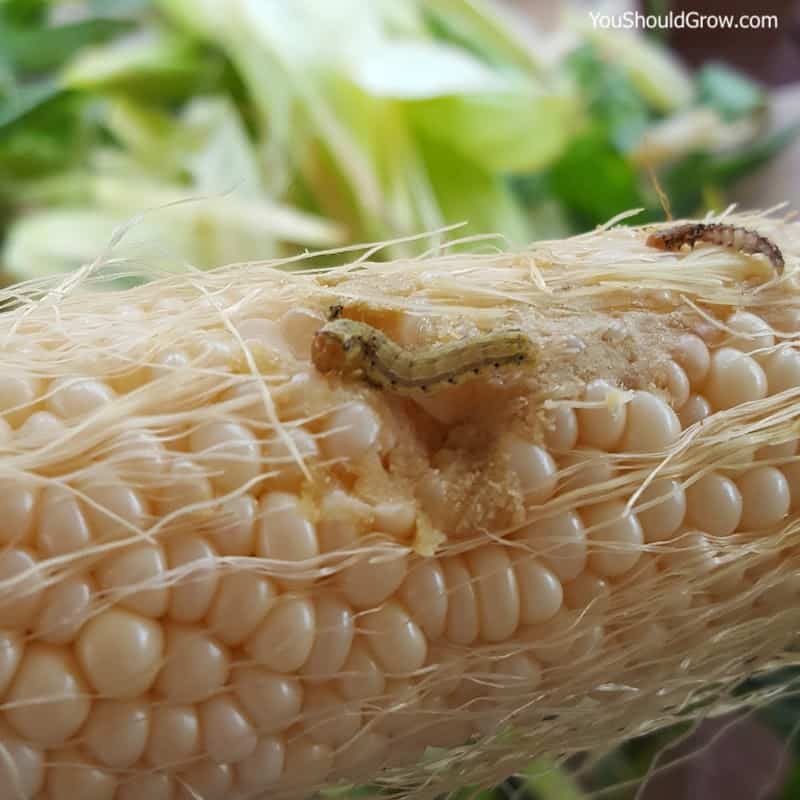
European corn borers will feed on the leaves and bore into the ears, and cucumber beetle larvae like to feed on corn roots.
Organic pest control options: You can prevent or minimize worms in your corn by applying Bt, a soil-borne bacteria used for organic pest control, and spinosad, a naturally occurring pesticide.
Growing corn can also attract birds, raccoons, and deer that can munch on your growing plants and ears. A good tall or electric fence can help deter deer. Human hair, scarecrows, and flags can also make your cornfield less attractive to animal pests.
Diseases of corn
You may find that you have to deal with some disease problems when you grow corn.
Corn smut
This infection is a fungal disease of corn which causes bluish swollen kernels of corn that are filled with spores. If you find these blue-black galls on your corn, remove them so they don’t spread the fungus.
In Mexico, these fungal galls are a delicacy known as huitlacoche.
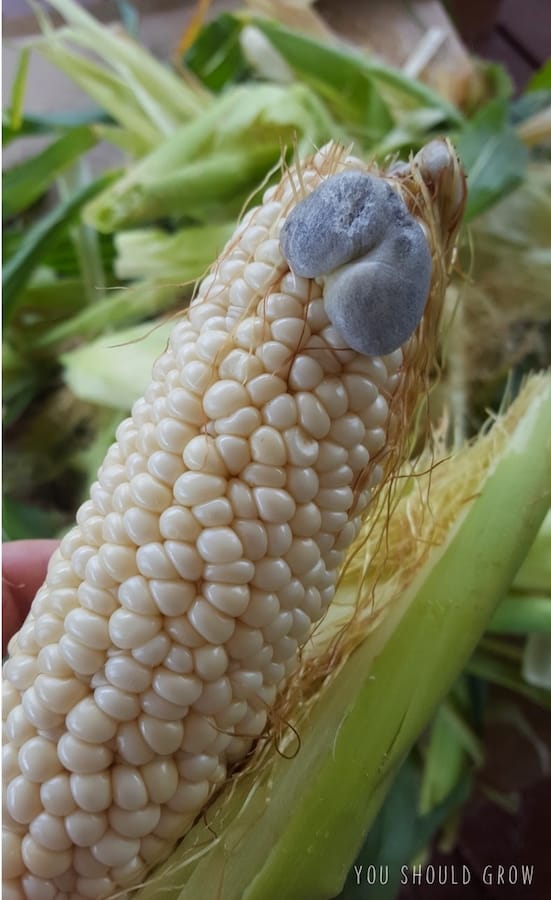
We always have a few ears that get infected, so we decided to try it this year. My husband cooked it with garlic and served it as a side dish with dinner.
It tasted kind of like corn but also had an earthy-mushroom flavor. The texture was not my favorite thing. We’d never tried to cook with it before so it may taste better when prepared by someone more familiar with it.
Bacterial wilt in corn
Bacterial wilt is another common disease of corn. Young plants the get infected may wilt and die. Older plants infected with wilt develop yellow streaks or spots on the leaves and entire leaves may turn brown and die.
The best practice for controlling diseases of corn is to practice good crop rotation and plant resistant varieties. Disease resistant varieties of corn may develop symptoms of disease but will continue to grow and produce ears of corn despite infection.
Harvesting and Storing Corn
Sweet corn is ready to harvest about 3 weeks after the silks appear. To see if your corn is ready to harvest, peel back the tip of the husk and pierce a kernel with your thumbnail.
If you get a spurt of milky substance, your corn is at the ideal stage for harvesting. Eat it or preserve it as soon as possible to maintain the best flavor.
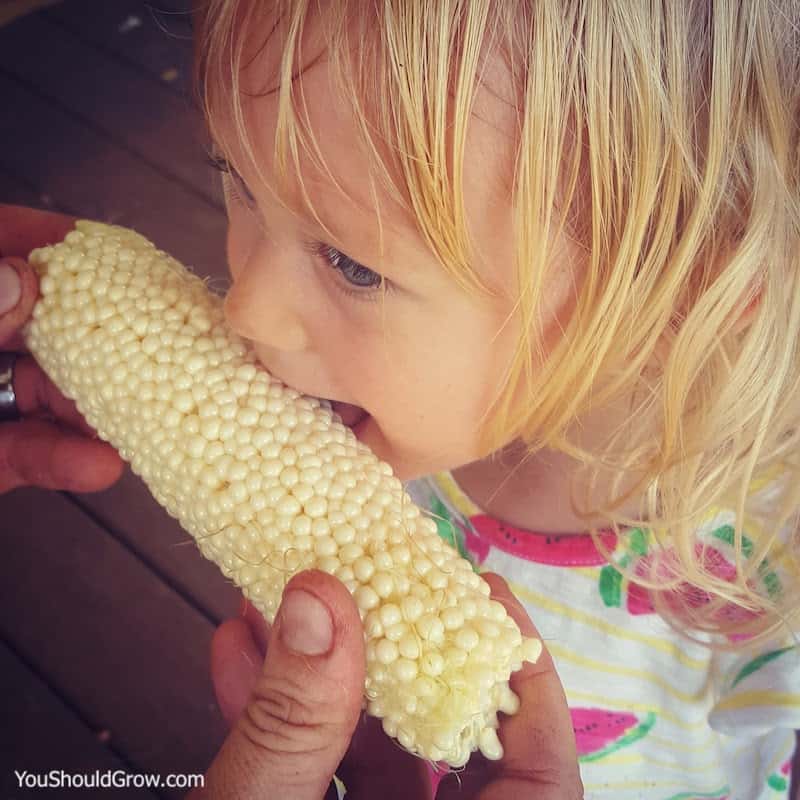
When the silks are dried and the husk is pale, the corn is past its prime for fresh eating. If you want to harvest it for cornmeal, leave the ear on the stalk until it is dried out.
Your freshly harvested corn tastes best in the first 24 hours, so go ahead and cook or preserve it as soon as possible.
You can store corn in the husk in your refrigerator for up to 3 days. Corn can also be frozen, canned, dehydrated, and fermented.
Check out these links for more information about each method of storing corn.
Summing it up
I know this is a long post, and I’ve talked about a lot of different things. So I thought it would be nice to end this post with a quick summary of my best tips for growing corn.
- Choose the right variety. Read through the descriptions of each variety in your seed catalog to make sure you’re getting one that works for your growing season and taste preferences. SH2 hybrid corn varieties are the sweetest sweet corn varieties.
- Don’t plant different varieties or types of corn next to each other. They’ll cross pollinate, and that will affect the flavor and texture of the end product.
- Plant your corn in blocks, not long rows. Make sure you get the sweetest, plumpest ears this summer by planting a minimum of 4 rows of 4 plants each.
- Make sure your corn plants get adequate water, especially after the tassels and silks appear. One inch per week is the recommended amount.
- Corn is a heavy feeder in the garden. Plant your corn in fertile soil and/or add fertilizer at least twice during their growing season.
- Choose disease and pest resistant varieties if you’ve had trouble growing corn before.
If you have enough space, you should definitely add corn to your garden this year. Homegrown corn is right up there with a homegrown tomato for summer’s best produce.
Leave me a comment below, and tell me about your successes, troubles, and favorite things about growing corn.


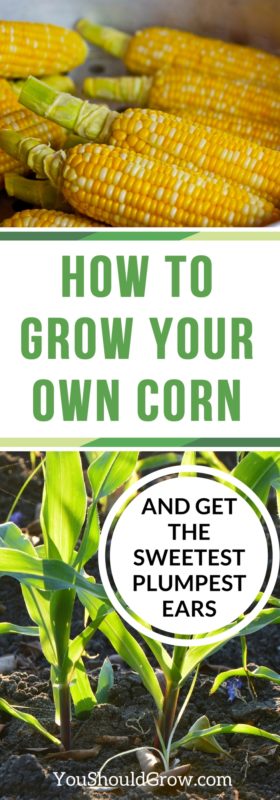
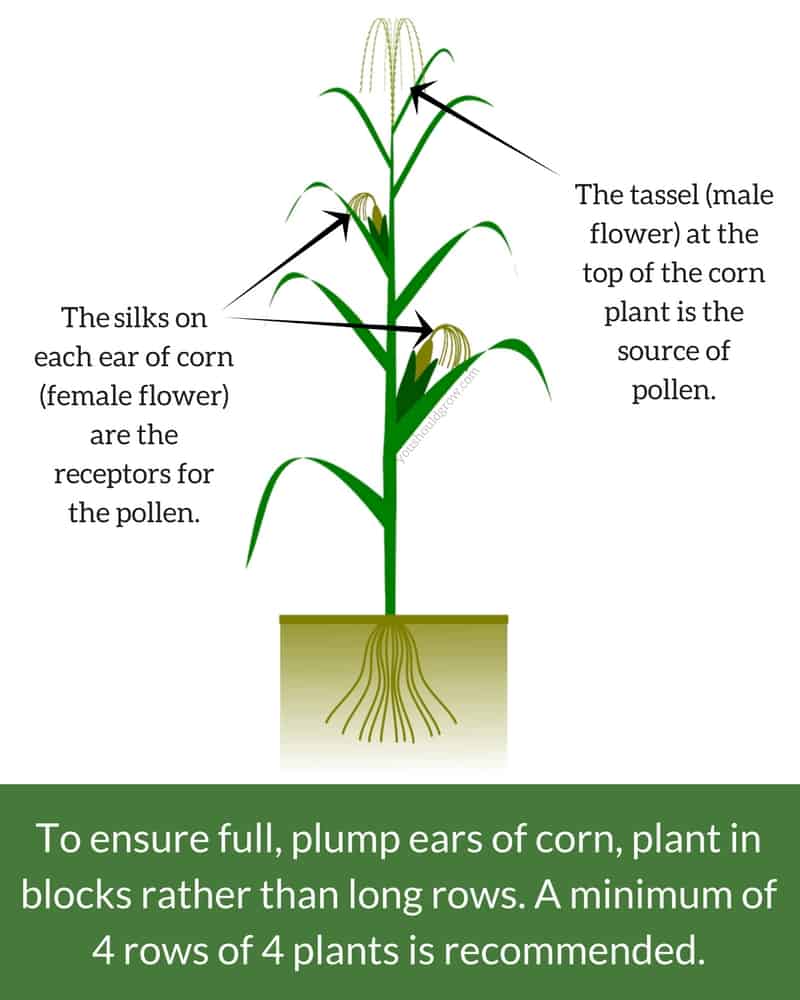
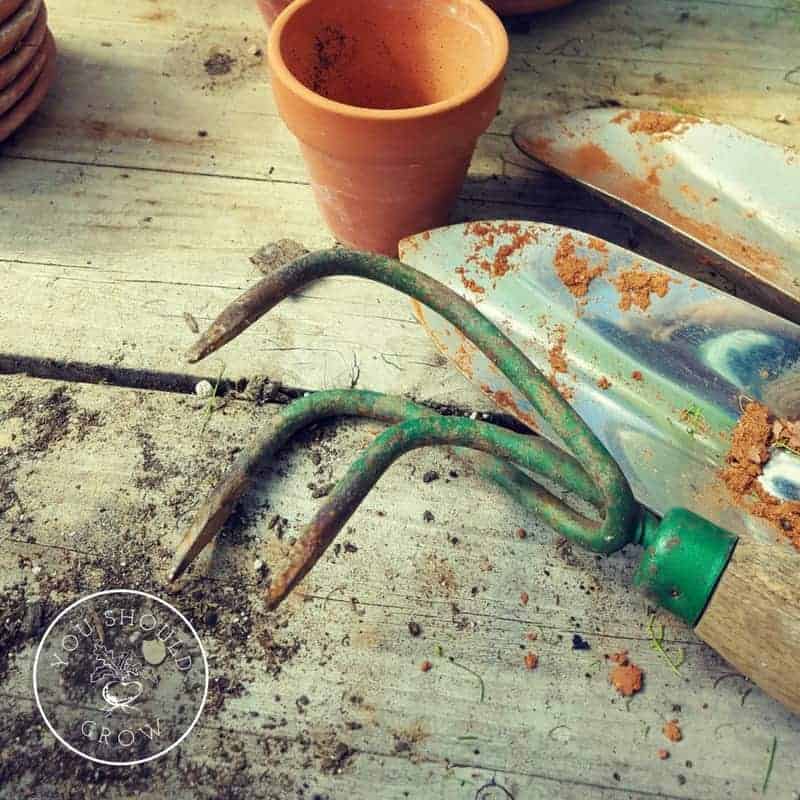
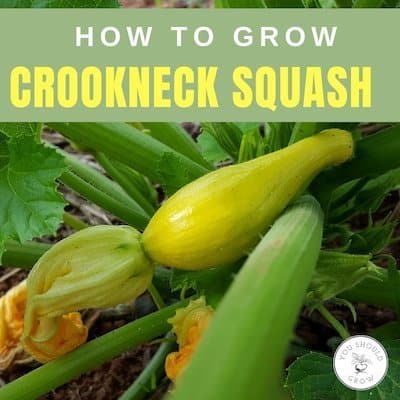
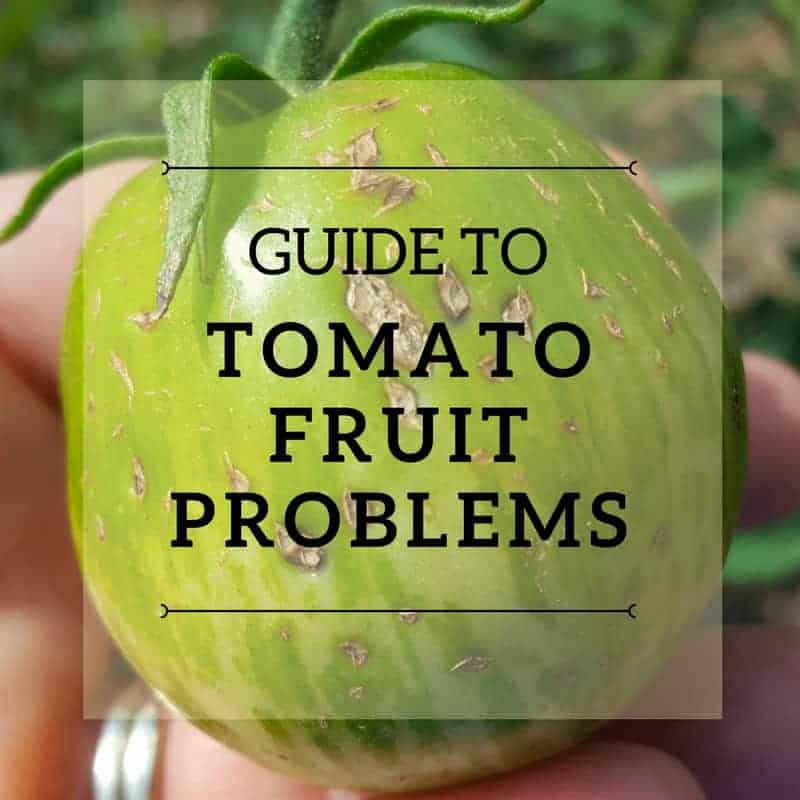
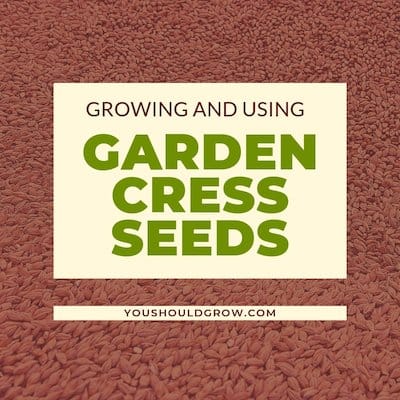
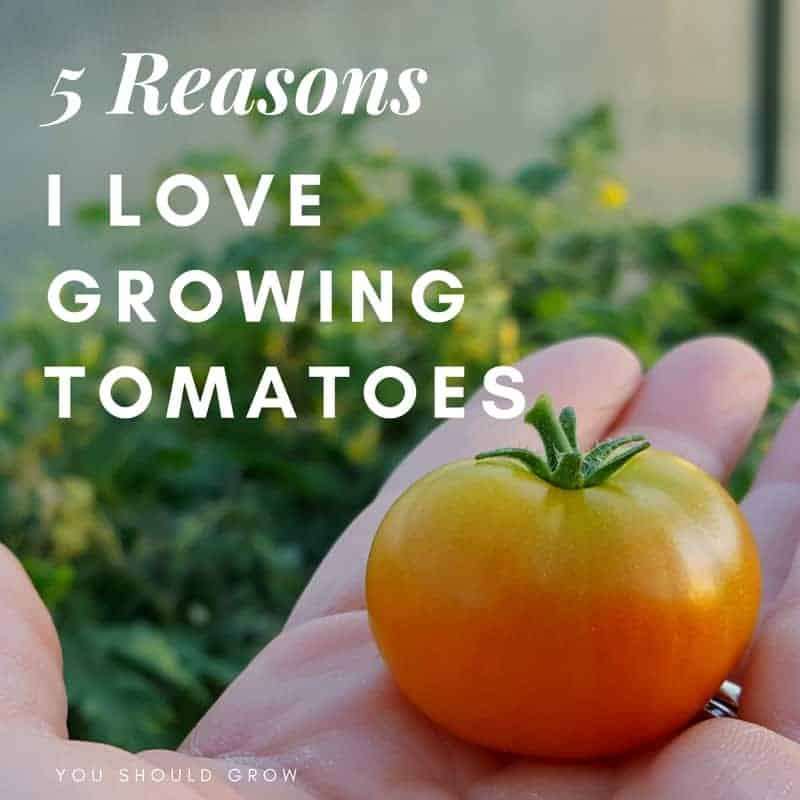
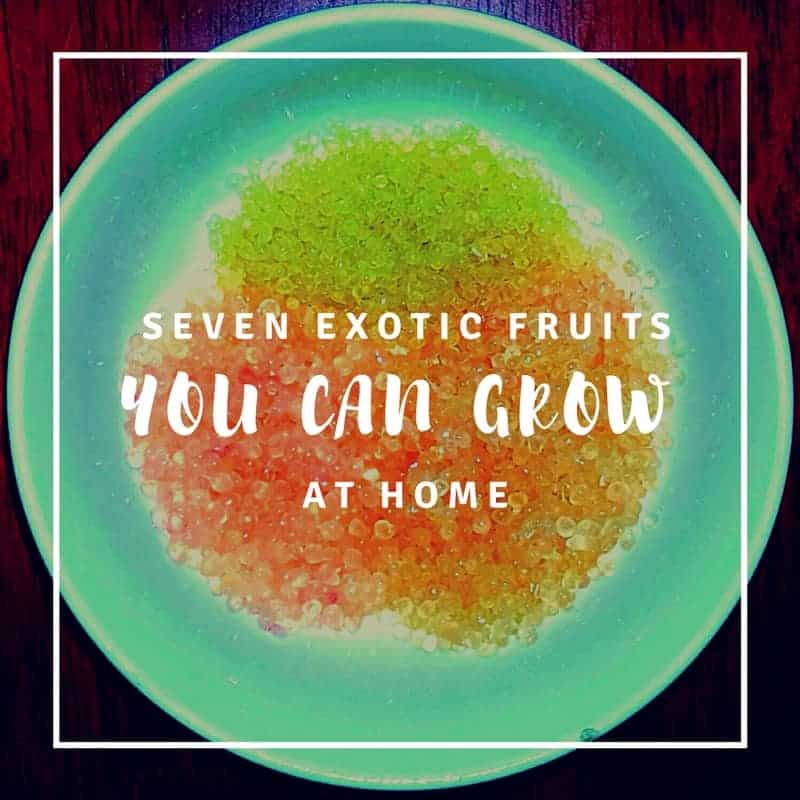
This was a good read! I’ve had a hard time getting good sweet corn going!
Thanks! I hope it works out for you better this year!
There were very less kernals/grains in one ear….can we hand pollinate these silk hair
Hi, Lincy! I don’t see why you couldn’t give it a try, but I would expect hand pollination to give spotty results for corn. Corn is wind pollinated so it’s best to plant at least 16 plants in close proximity so you get the most plump kernels. If you don’t get a lot of wind, you can walk through your corn patch tapping the stalks to encourage pollen to be released from the flowers.